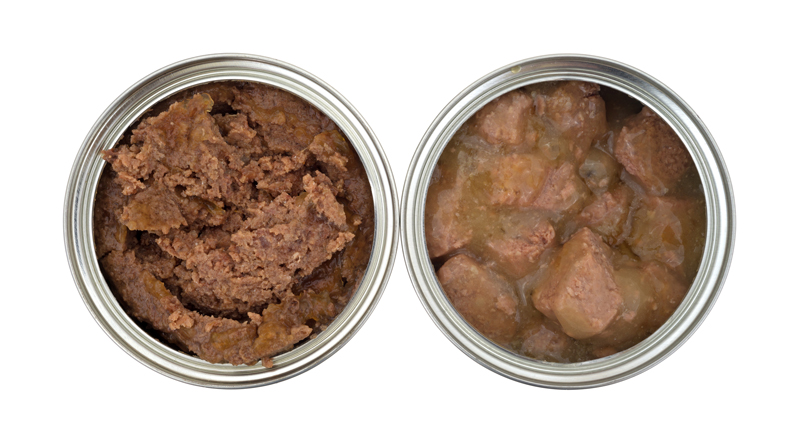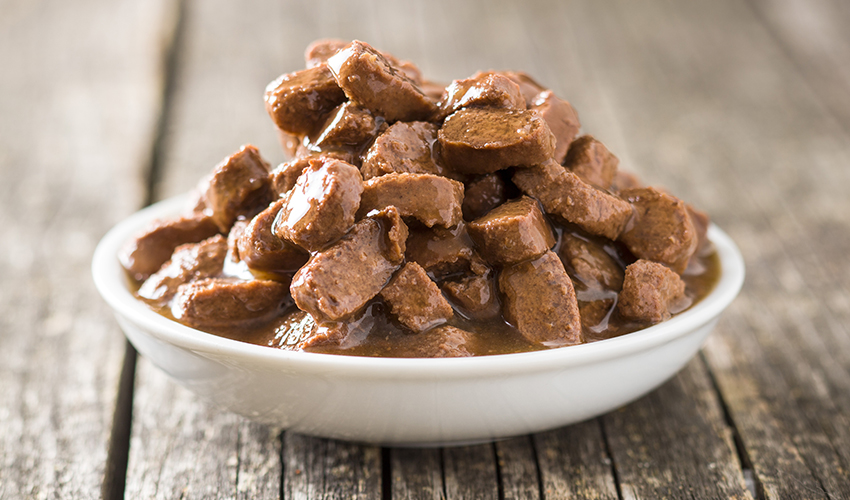Dog food labeling can be confusing, misleading, covered in marketing claims, and full of acronyms and mysterious ingredients.
But everything else, well, it can take some research to understand exactly what’s going on. Take moisture content, for example.
According to the Pet Food Institute (PFI), sometimes considered a lobby group for the pet food industry, but nonetheless a robust source of information on the ins and outs of pet food, dry pet food contains 10 to 12 percent moisture content, while wet pet food contains 75 to 85 percent moisture.
You can find the amount of moisture reflected in the Guaranteed Analysis (GA) on a pet food package. A GA means the pet food contains what it says it contains and has been through a food trial or a lab test.
Clearly, wet food contains more moisture than a dry kibble — it’s readily apparent in the food itself. Canned and wet dog food can be used interchangeably, and here both refer to dog food packaged in cans.
Moisture content doesn’t actually mean much on its own in terms of the quality of one specific dog food. Dry and wet food can both be nutritious for a dog.
People may choose wet food if their dog doesn’t drink much water because it’s a handy way to keep their dog hydrated. Others prefer canned food because it’s easier for their dog to eat, or their dog really loves it. Senior dogs with dental issues may find canned or wet easier to eat.
To further complicate things, there is a category of dog food called “semi-moist”. Semi-moist food contains 14 to 34 percent moisture. It’s not as popular as plain old kibble or canned food.

The problem, for pet owners, is comparing the overall nutritional profile of dry food to wet food. Comparing wet and dry food packages is tricky. It’s far easier to compare canned food to canned food.
“The GA on dog and cat food labels are often presented “as-fed.” This means the moisture in the food is included when calculating the other nutrient values,” according to the Pet Food Institute website. “When comparing the nutrient levels between two pet food products, look first at the percentage of moisture.”
Because of the wildly different moisture levels between canned dog food and dry dog food, it can be hard to compare the nutritional value of wet food to dry food in order to determine what might be the best option for your dog. Food needs to be compared on a “dry matter” basis. You have to pretend both foods don’t contain any moisture at all.
Fortunately, the PFI has instructions on how to do this:
You’ll need to follow those steps for each product or ingredient you’re comparing to determine what is the best option for your pet. You probably weren’t expecting to do the math to figure out what you should feed your dog! But doing this enables you to compare things in a more apples to apples way, and less apples to oranges.
There are other tools to help you with this online.
Another confusing aspect of moisture in canned wet food is how you interpret the percentages.
“Many dog owners think of moisture or water content being filler, or used in place of proper ingredients or nutrients — and this theory would mean that a food that has a moisture content of 75% would have 75% water added to just 25% of actual ingredients,” according to the Pets4Homes website.
But actually, it reflects the natural moisture of the food. Meat and veggies contain water, although, sometimes water is added during the canning process.
Dry food has most of its moisture removed, even if moisture from the meat and other ingredients had originally been present. This helps it last longer and be shelf-stable, as well as give it that distinctive crunch dogs seem to love.
One thing you can always do to make things a little easier on yourself when it comes to selecting high-quality food is to look for a product that lists specific animal protein as the top ingredients. Generally, foods that have animal proteins in the top ingredients contain fewer fillers and are more nutritious. This is because ingredients are listed in descending order of weight.






